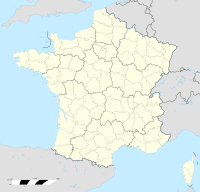Operation Royal Marine facts for kids
Quick facts for kids Operation Royal Marine |
|
|---|---|
| Part of the Second World War | |

Soufflenheim and vicinity
|
|
| Operational scope | Tactical |
| Location | Rhine, Moselle, Meuse rivers 48°50′N 7°58′E / 48.83°N 7.96°E |
| Planned by | Winston Churchill |
| Commanded by | Commander G. R. S. Wellby |
| Objective | Obstructing German rivers and canals with fluvial mines |
| Date | May 1940 |
| Executed by | Military Intelligence Research [MIR(c)], Royal Navy parties |
| Outcome | Temporary suspensions of German river traffic and damage to barge barriers and bridges |
Operation Royal Marine was a secret British plan during the Second World War in May 1940. It happened during the Battle of France. The British planned to float special mines down rivers that flowed into Germany from France. The main goal was to damage German bridges, barges, and other boats on the rivers.
The French government was worried about Germany fighting back, so they asked for many delays. But the operation finally started on May 10, 1940. This was the same day Germany launched its big attack in the west. The mines did cause some damage and slowed down German river traffic on the Rhine between Karlsruhe and Koblenz. They also damaged some bridges and protective barriers.
Part of the plan was for Royal Air Force (RAF) planes to drop mines into rivers and canals at night when the moon was bright. However, this part of the plan barely started before the battle ended. The operation's small success was lost because the Allies were defeated. Also, France and Germany signed a peace agreement in June 1940.
Contents
Why Operation Royal Marine Was Planned
During a quiet time in the war called the Phoney War, the French government was concerned. They worried that if the British mined German rivers, Germany would attack French waterways from the air. Even so, Operation Royal Marine was meant to happen at the same time as Operation Wilfred.
Operation Wilfred was a plan to place mines in the waters around Norway. The British hoped that starting Operation Royal Marine would make the United States pay attention to it. This would distract from any questions about whether Operation Wilfred was against international rules. Operation Wilfred aimed to force German ships carrying iron ore from Sweden into international waters. There, the Royal Navy could attack them.
The British and French also wanted to show they were actively fighting Germany. They faced criticism that they were only attacking smaller countries they claimed to protect. On March 28, 1940, the leaders of Britain and France decided to start Operation Royal Marine on April 4. They also planned for planes to drop mines by April 15.
However, the French War Committee quickly said no to this plan. They did not change their mind for about three months. So, Operation Wilfred went ahead on its own on April 5. It was later delayed to April 8, and parts of it were cancelled when news came that the German fleet had sailed. Eventually, Britain and France agreed that Operation Royal Marine could begin as soon as Germany started its attack in the west.
Getting Ready for the Operation
The Plan to Use River Mines
Winston Churchill first showed this plan to the British government in November 1939. He saw it as a way to get back at Germany for illegally placing their own mines. Sir Edward Spears later said he had given Churchill the idea in August 1939. But by the time the operation started, Churchill thought it was his own idea.
The plan was to use 2,000 special river mines, with 1,000 more being made each week. Naval teams, led by Commander G. R. S. Wellby, would place these mines in French rivers that flowed into western Germany. The sailors would be based near the Maginot Line, about 5 miles (8 km) from the Rhine. Their goal was to disrupt commercial boat traffic for 100 miles (160 km) past Karlsruhe.
These mines were designed to damage barges and other river boats. They would then stop working before they reached the Netherlands, which was a neutral country. On March 6, 1940, the government was told that mines would be ready to be dropped from riverbanks by March 12. RAF bombers would also start dropping them by mid-April, between Bingen am Rhein and Koblenz, on moonlit nights.
Neutral countries were to be warned. The first 300 to 400 river mines were ready by the night of March 14/15. But the French objected again, fearing German attacks, so the plan was delayed. In April, Churchill tried to convince the French to agree to Royal Marine. After meeting the French Prime Minister, Édouard Daladier, Churchill said, "We are going to miss the bus."
The Special Mines Used
The mines for this operation were specially created by Ministry of Defence 1 (MD1). This group was also known as Churchill's Toyshop and focused on developing new weapons. The mine was called the 'W' Bomb. Millis Jefferis designed it. He received the request on November 10 and had a working model ready by November 24.
Jefferis's assistant, Stuart Macrae, came up with a clever way to make the mine explode after a delay. He used a soluble chemical pellet, like an Alka-Seltzer tablet, which dissolved at a predictable speed. Each mine held 15 lb (6.8 kg) of Trinitrotoluene (TNT), a powerful explosive.
Tests of the mines took place in the Thames in December 1939. Depending on their type, some mines floated, while others bounced along the riverbed. At that time, Jefferis's department only had three people. So, local Sea Scouts helped with the tests, following the mines in a boat after they were dropped from Chiswick Bridge. Over 20,000 'W' Bombs were made during the war.
How the Operation Happened
On May 10, 1940, mines were released into the Moselle. The goal was to destroy floating bridges built by German army engineers. Other mines were put into the Rhine, but they did not have much effect at first.
On May 13, the British placed 1,700 mines in the Rhine near Soufflenheim. General Victor Bourret, who commanded the French Fifth Army, reported that these mines damaged the barrier protecting the bridge at Karlsruhe. Several floating bridges were also damaged. River traffic was stopped for a while between Karlsruhe and Mainz.
By May 24, more than 2,300 mines had been released into the Rhine, Moselle, and Meuse rivers. On June 9, General Andre-Gaston Pretelat, commander of the French Second Army Group, ordered more river mines to be sent down the Rhine. He hoped this would slow down a German attack on the Maginot Line.
RAF Bomber Command also began dropping mines between Bingen and Koblenz. They also dropped them into canals and river mouths that led to the Heligoland Bight. However, planes laid only a few mines before the Battle of France ended. It was hard to measure how much damage these air-dropped mines caused.
What Happened After
In his book Assignment to Catastrophe (1954), Edward Spears talked about the operation. Spears was Churchill's representative to the French Prime Minister. He had first suggested mining German rivers in 1939. He quoted Churchill from his book Their Finest Hour (1949), saying:
The success of the device was, however, lost in the deluge of disaster.
—Churchill
This means that any good the mines did was overshadowed by the huge disaster of the Allied defeat in France.


